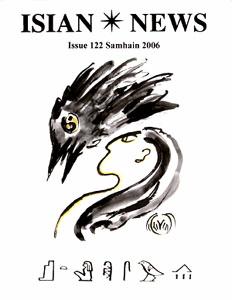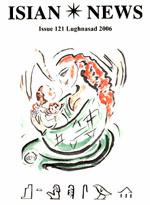Nephthys (Nebet-hes)
By Michael A. Starsheen
Nephthys is the dark twin sister of Isis, in much the same way that Set is the dark twin brother of Osiris; however, unlike Set, Nephthys never turns on Isis or acts out in ways that can be described as evil.
Both Isis and Nephthys are bird goddesses, and are often shown winged, especially when they stand behind Osiris in the Hall of Judgment, where they act as the "Double Ma'ati." They are also shown winged on the outer lid of the sarcophagus, protecting the pharaoh, and on the Ark of the Covenant, which was copied from those sarcophagi.
Nephthys is the Greek version of Her name, which is actually Nebet-hes. "Nebet" means "Lady", and "Hes" means "House" in a specific context, i.e., Nebet-hes is the Lady of the House where the Moon travels through the Night Sky, in the same sense that Het-Heru (Hathor) is the house where the Sun travels through the Day Sky.
You usually see Nebet-hes with her hieroglyphic name on her head, which is a rectangular house with a door enclosing a half-round "t" symbol, topped by an openside-up basket, or "neb" symbol.
Nebet-hes is always shown as a friend of the dead in the Pyramid texts, indeed, she performs for the dead soul the function she performed for the primeval Gods as "Neb-Khat," the Lady of the Body, in which she assembles the pieces and fashions the physical body. A side note: the physical body, or "khat", denotes "dead meat." It does not live until the "ka," or "enlivening force" infuses it. So even though Nephthys assembles the "khat," she cannot make it live. That requires other magics than hers. She must work with Isis, Thoth, and Anubis to resurrect "Osiris".
She was also known as the "Lady of Heaven," Mistress of the Gods," Sister of the God, eye of Ra," and "sister of the creative goddess who lives within Annu." She was not one of the ancient most Nome gods, but her centers were smaller towns: Senu, Hebet, Behbit, Per-mert, Re-nefert, Het-sekhem, Het-Khas, Ta-keheset, and Diospolites. She may also have had shrines associated with Set or with Isis.In the beginning of the Twins' time on the Earth, after Ra turned the rulership over to Osiris, Nephthys remained with Set as his wife, except when he was charging around into the desert hunting or on the Nile fishing, or otherwise "hanging out with the guys." Then she would spend her time with Isis, learning from her about healing and magic.
When Set trapped Osiris in the coffin and threw him into the Nile, Nephthys was horrified, and confronted her husband over his actions. He told her, shamelessly, that it was *their* turn to rule the Two Lands, and to make herself ready. She went from Set straight to Isis, who had been away when this attack had occurred, and told her of Set's trickery. Isis asked Nephthys to remain with Set to keep her informed of his movements, and began her long search for Osiris' body. Thus Nephthys made her choice apparent between good and evil, light and dark, and she remained Isis' companion forever afterward.
I had a vision a few years ago, when I was meditating on the relationship between Isis and Nephthys. I saw them balanced in the classic I Ching circle: Isis on the light half and Nephthys on the dark half, identical twins facing each other. But Isis, the light twin, held a piece of her dark twin at her heart, and Nephthys held a piece of Isis, her light twin, at her heart. There was no way to separate them because they flow into and out of each other.
Nephthys is "Neb-khat," while Isis has the Ren of Ra, and the ability to speak the "ka" into any "khat" Nephthys might form. Between the two of them, they can fashion a new body and enliven it, just as they do when they make a new penis for Osiris and make it live long enough for Isis to conceive Horus (more later). The two Ma'ati work together, and it is a mistake to talk about one of them in isolation. Even though Isis is far more famous, we should not forget her dark Twin!
The Conception of Anubis
There are two threads of thought concerning the fatherhood of Anubis. Some (later) texts maintain that his father was Set, but most texts agree that his father was Osiris. I agree with the latter for several reasons. First off, Osiris represents the fertile, black land along the Nile, and the grain that generates from it, which is why he is depicted with green skin. Set, on the other hand, is associated with the desert Red Land, of blowing sand, rock, and sterility, which is why he is depicted with red hair and black skin. So there's a good chance that Set was sterile from "birth," just by association.
Secondly, Set doesn't spend much time with Nephthys. She spends all her time with Isis and Osiris, in their court. Set spends his time hunting, fighting, drinking, and carousing. They simply don't overlap that often.Third, there are the several stories during the growth and revenge stories of Horus that allude to Set's infertility, if not impotence. So it is unlikely that he could have fathered Anubis, if he had been around to try.
So here is the story that seems most likely.
Nephthys comes to Isis weeping because she wants a son, desperately. She is ignored by Set, and lonely for company at court. Isis, after all, rules in her husband's stead, so she has something to do. Nephthys has nothing. Isis is moved by her sister's tears, and agrees to help. Osiris was due home from a long trip that night, so Isis dressed Nephthys in her finest gown, and put an ornament on her head that holds some of Isis' light. She dressed her sister's hair and face in the way that Isis usually appeared, and coached her on how to walk and talk with Osiris.
And when the two were alone together, Isis had given her sister an enchanted ointment to massage on Osiris' shoulders that would help him to yearn for her. Osiris and Nephthys spent the night is a glorious confusion and, at dawn, Isis replaced Nephthys in her husband's arms.
Nine months later, Isis and all the birthing goddesses gathered around to help Nephthys bear her Son. Everyone was sure it would be a boy—She was carrying high! Set had been unbearable among his friends concerning his obvious potency, and was carrying on buying rounds of barley beer for everyone while waiting for the boy to appear.
At last the cry came, and the baby made his appearance! But, lo! He wasn't at all what anyone expected. The little boy's body was well formed, and obviously male, but that *head!* Anyone could see that he had fallen under the curse of the jackal of the desert at some point, or *that his father had!* Nephthys named her boy, Anubis, and was completely delighted with him, as was Isis, even while everyone else was speculating about what Set had been up to.
Set, when he first saw the boy, disowned him at once, even though he was the only other animal-headed God that Nephthys would likely have lain with. His son would have been more like Ra, if you had asked his opinion, which no one did. Too many were busy saying, "Like father, like son." (Which, of course, is where the rumor got started that Set was Anubis' father.)
No one *ever* expected that Anubis was the son of Osiris! *Ever!*We will tell the tale of Anubis growing up and becoming the second most important God in the Duat, after Osiris, in a later post. He deserves his own story!
And no one *ever* accused Nephthys of adultery with her sister's husband, because the child looked utterly unlike either of them. Such was the Great Magic of Isis!
 Olivia Robertson's cover drawing is of "The Raven Speaks" and her Reflections article is entitled "The Democratic Grael." Included are two more rituals from the next Liturgy booklet, "Ishtar of the Starry Heavens, Shape-Shifting of the Alchemical Twins," as well as FOI-related news.
Olivia Robertson's cover drawing is of "The Raven Speaks" and her Reflections article is entitled "The Democratic Grael." Included are two more rituals from the next Liturgy booklet, "Ishtar of the Starry Heavens, Shape-Shifting of the Alchemical Twins," as well as FOI-related news.

